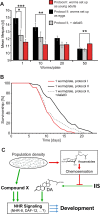Larval crowding accelerates C. elegans development and reduces lifespan
- PMID: 28394895
- PMCID: PMC5402976
- DOI: 10.1371/journal.pgen.1006717
Larval crowding accelerates C. elegans development and reduces lifespan
Abstract
Environmental conditions experienced during animal development are thought to have sustained impact on maturation and adult lifespan. Here we show that in the model organism C. elegans developmental rate and adult lifespan depend on larval population density, and that this effect is mediated by excreted small molecules. By using the time point of first egg laying as a marker for full maturity, we found that wildtype hermaphrodites raised under high density conditions developed significantly faster than animals raised in isolation. Population density-dependent acceleration of development (Pdda) was dramatically enhanced in fatty acid β-oxidation mutants that are defective in the biosynthesis of ascarosides, small-molecule signals that induce developmental diapause. In contrast, Pdda is abolished by synthetic ascarosides and steroidal ligands of the nuclear hormone receptor DAF-12. We show that neither ascarosides nor any known steroid hormones are required for Pdda and that another chemical signal mediates this phenotype, in part via the nuclear hormone receptor NHR-8. Our results demonstrate that C. elegans development is regulated by a push-pull mechanism, based on two antagonistic chemical signals: chemosensation of ascarosides slows down development, whereas population-density dependent accumulation of a different chemical signal accelerates development. We further show that the effects of high larval population density persist through adulthood, as C. elegans larvae raised at high densities exhibit significantly reduced adult lifespan and respond differently to exogenous chemical signals compared to larvae raised at low densities, independent of density during adulthood. Our results demonstrate how inter-organismal signaling during development regulates reproductive maturation and longevity.
Conflict of interest statement
The authors have declared that no competing interests exist.
Figures




References
-
- Warner DA, Shine R (2008) The adaptive significance of temperature-dependent sex determination in a reptile. Nature 451: 566–568. doi: 10.1038/nature06519 - DOI - PubMed
-
- Pen I, Uller T, Feldmeyer B, Harts A, While GM, et al. (2010) Climate-driven population divergence in sex-determining systems. Nature 468: 436–438. doi: 10.1038/nature09512 - DOI - PubMed
-
- Mair W, Dillin A (2008) Aging and survival: the genetics of life span extension by dietary restriction. Annu Rev Biochem 77: 727–754. doi: 10.1146/annurev.biochem.77.061206.171059 - DOI - PubMed
-
- Golden JW, Riddle DL (1982) A pheromone influences larval development in the nematode Caenorhabditis elegans. Science 218: 578–580. - PubMed
-
- Jeong PY, Jung M, Yim YH, Kim H, Park M, et al. (2005) Chemical structure and biological activity of the Caenorhabditis elegans dauer-inducing pheromone. Nature 433: 541–545. doi: 10.1038/nature03201 - DOI - PubMed
Publication types
MeSH terms
Substances
Grants and funding
LinkOut - more resources
Full Text Sources
Other Literature Sources
Research Materials
Miscellaneous

